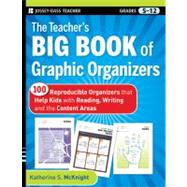
What is included with this book?
About the Author.
Chapter One: Why Are Graphic Organizers Such Important Tools for Teaching and Learning?
Chapter Two: Graphic Organizers for Brainstorming and Idea Generation.
1: Power Thinking (Levels of Brainstorming).
2: ABC Brainstorm.
3: Carousel Brainstorm.
4: Venn Diagram.
5: Compare and Contrast.
6: KWL.
7: KWS.
8: KWHL.
9: KWLT.
10–17: Topic Generation Graphic Organizers.
10: Topic Generation with 3 Ideas–Linear Model.
11: Topic Generation with 4 Ideas–Linear Model.
12: Topic Generation with 6 Ideas–Linear Model.
13: Topic Generation with 3 Ideas–Circle Model.
14: Topic Generation with 4 Ideas–Circle Model.
15: Topic Generation with 6 Ideas–Circle Model.
16: Character Traits Web.
17: Topic Generation: Hand Model.
18: Anticipation Guide.
19: Hypothesis Guide.
20: Idea Web.
21: Fishbone.
22: Spider.
23: Herringbone.
24: Y Diagram.
Chapter Three Graphic Organizers for Vocabulary Development.
25: Vocabulary Slide.
26: Concept or Vocabulary Map I.
27: Concept or Vocabulary Map II.
28: Concept or Vocabulary Map III.
29: Concept or Vocabulary Map IV.
30: Word Detective.
31: Six-Column Vocabulary Organizer.
32: Vocabulary Tree.
33: Cyber Vocabulary Detective.
Chapter Four Graphic Organizers for Note Taking and Study Skills.
34: Cornell Notes.
35: Three-Column Notes.
36: T Notes.
37: Analysis Notes.
38: Summary Organizer.
39: Journalist Graphic Organizer.
40: Story Board Notes: Three Frame.
41: Story Board Notes: Six Frame.
42: Outline Notes.
43: The Five Senses.
44: Cycle or Food Chain.
45–48: Graphic Organizer Bookmarks.
45: Bookmark for Reading Fiction.
46: Reading Reminders Bookmark.
47: Bookmark for Questions During Reading.
48: Textbook Reminders Bookmark.
49: Individual Performance in a Cooperative Group.
50: Cooperative Group Planner.
51: Portfolio Tracker.
52: Independent Reading Log.
53: Assignment Tracker.
Chapter Five Graphic Organizers for Supporting Reading Comprehension.
54: Questioning the Author.
55: Question-Answer-Relationship (QAR).
56: Gist.
57: Survey, Question, Read, Recite, Review (SQ3R).
58: Survey, Question, Read, Recite, Review, Reflect (SQ4R).
59: Fix-Up Strategies.
60: Reading Connections.
61: ReQuest.
62: Story Trails and History Trails.
63: Text-Think-Connect (TTC).
64: REAP.
65: PLAN.
66: PACA.
67: DRTA.
68: Text Structures.
69: Reference Frames.
70: Prior Knowledge.
71: Inference Prompter.
72: List-Group-Label.
73: Think-Pair-Share.
74: The Five Ws.
Chapter Six Graphic Organizers for Writing.
75: Autobiographical Poem.
76: Historical Bio Poem.
77: Inquiry Chart.
78: Peer Review.
79: Entrance Slip.
80: Exit Slip.
81: Writer Checklist.
82: Sensory Starter.
83: Story Map I.
84: Story Map II.
85: Chain of Events.
86: Beginning-Middle-End.
87: Climax Ladder.
88–91: Persuasive Writing Organizers.
88: Persuasive Writing I.
89: Persuasive Writing II.
90: Persuasive Writing III.
91: Persuasive Writing IV.
92: Writing Revision Organizer.
93: Prewriting Organizer.
94: What Happens?
95: Character Creator.
96: Conflict and Solution Organizer.
97: Getting Ready to Write.
98: Writing Process.
99: Story Pyramid.
100: RAFT.
References.
The New copy of this book will include any supplemental materials advertised. Please check the title of the book to determine if it should include any access cards, study guides, lab manuals, CDs, etc.
The Used, Rental and eBook copies of this book are not guaranteed to include any supplemental materials. Typically, only the book itself is included. This is true even if the title states it includes any access cards, study guides, lab manuals, CDs, etc.